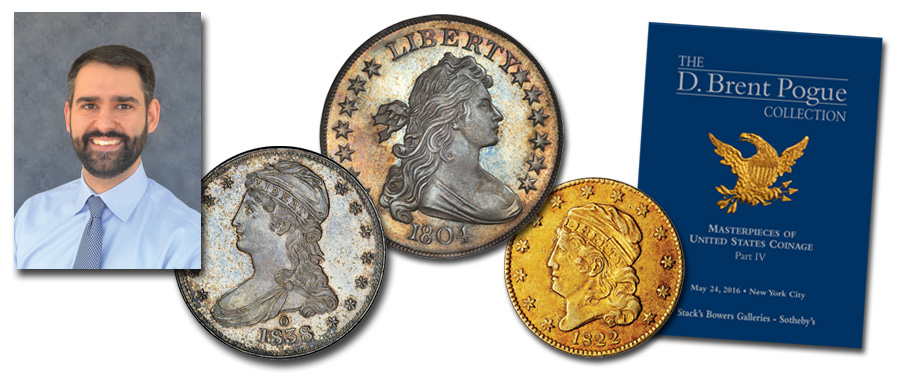
Just as history is always
more intricate and intense as it is being lived than it seems in retrospect,
assembling a collection like this one is a more complex endeavor than a neatly
organized auction catalog containing 63 superb coins may make it seem. While
the coins acquired by D. Brent Pogue and his father Mack fill this catalog, the
fourth in a series, what’s not included perhaps defines the Pogue Collection as
much as what is included. Nowhere on the pages to follow will there be evidence
of the hundreds, perhaps thousands, of auction catalogs that were scanned and
set aside after discovering they offered no coin important enough to add to
this collection. The hours of phone conversations held with trusted advisors are
unrecorded and unmentioned. Trips to dozens of coin shows across the United
States, peering in cases and fielding offers from all comers, are not cited
within, nor are the years of experience required to discern true gems from
fool’s gold. Much of this collection was formed before the era of
certification, placing extra importance on the eyes and courage of the
purchaser. The expertise and confidence needed to purchase coins in such an
environment is implicit here, even as the results of those processes are
evident to all.
This collection was
formed one coin at a time. While a few small groups were acquired en bloc,
including the Lawrence Stack Type Set and the Foxfire Collection, most were
added as they revealed themselves singly to the marketplace. Such an endeavor
requires both patience and quick reflexes, the former enabling a collector to
wait for the right coin, the latter allowing them to pounce when it becomes
available. The spaces in between acquisitions were full of study, consuming
books and catalogs, listening more than speaking when experts were around, and
studying far more coins than will ever bear the Pogue provenance.
Building a catalog is not
entirely unlike forming a collection. For every research reference that is
cited, several more proved useful, and dozens of further sources were examined
despite yielding little. Experts in every specialty allowed ready access to
their knowledge and libraries, typically on a deadline and with nothing in
return but gratitude. The brute labor of numismatic research is not a
profitable endeavor, but people like Saul Teichman, Craig Sholley, John
Dannreuther, P. Scott Rubin, and others harvested facts with a sharpened scythe
for years in expectation of no greater return but the joy of discovery and the
pleasure of their work proving useful. It has, and to these gentlemen and
others, who opened their notebooks, libraries, and memories, I am grateful
beyond words.
Just as the work of coin
buying became a little easier after the dawn of coin certification, so too has
the work of numismatic research become less onerous in the age of digitization.
Had the extraordinary riches of the Newman Numismatic Portal been available
when the first three D. Brent Pogue catalogs were being written, they might
each be a pound heavier. Only time limits the amount that can be discovered
from the published works and unpublished archives made available by the NNP.
Other institutions have also made these travails less trying, including the
American Numismatic Society and the American Numismatic Association, whose
searchable digital archive of The Numismatist makes membership one of
the numismatic community’s greatest bargains.
With some sadness, this
catalog ends the presentation of the half dollars and half eagles of the D.
Brent Pogue Collection. These denominations formed the heart and soul of the
cabinet. The half eagles, in particular, are easy to access as the finest such
grouping ever assembled. Before this catalog, there was only one living
numismatist who had ever cataloged an 1822 half eagle. It’s humbling to become
the second name on the list. The silver dollars herein, though few in number,
pack perhaps the greatest punch, coin-for-coin, of any selection of the series
ever offered.
The intricacy and
intensity of the day-by-day production of this work would not have been
possible without the synergistic help of Stacks Bowers Galleries employees in
three different offices, as well as the aid of my wife and family here in South
Carolina. Late night texts from California to confirm a provenance,
mid-afternoon assurances that the home front was under control, and early
morning access to the vault on 57th Street are contributions that will never be
described in the pages of a catalog, but they were nonetheless vital and
appreciated.
The Pogue Collection was
formed to be enjoyed by others, but also because of an individual’s love of
numismatics. This catalog was written the same way. I hope you enjoy it.





